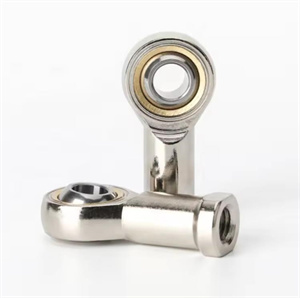Ball joints have the following characteristics:
Multi directional motion capability: Ball Joints allow connectors to move freely in multiple directions, as their design allows one spherical part to rotate freely within another spherical or hemispherical part. This makes them very suitable for applications that require multi-directional flexibility.
Strong load-bearing capacity: Ball joints can withstand forces and moments from multiple directions, as the spherical part can evenly distribute the load within the ball socket. This design allows the ball joint to maintain stable performance even under heavy loads.
Compact design: Ball joints typically have a more compact design compared to other types of joints, making them particularly useful in space limited applications.
High reliability: Ball Joints are carefully designed and manufactured to ensure reliable performance in various environments and application conditions. They typically have a longer lifespan and lower maintenance requirements.
Easy to install and disassemble: Many Ball Joints designs consider the need for easy installation and disassembly. These joints typically have a simple structure and quick connection methods for quick replacement or repair when needed.
Good sealing performance: Ball joints usually have good sealing performance, which can prevent liquid or gas leakage. This is crucial for applications that require maintaining system sealing.
Widely applicable: Ball Joints have a wide range of applications in various fields, including automotive suspension systems, aerospace equipment, industrial machinery, robotics technology, and other fields that require flexible connections and movements.
Joint bearings are spherical sliding bearings, consisting of inner and outer rings with spherical sliding spherical contact surfaces. Rod end joint bearings mainly consist of an inner ring with an outer spherical surface and an outer ring with an inner spherical surface, which can withstand large loads. According to its different types and structures, it can withstand radial loads, axial loads, or combined loads that exist both radially and axially.
Due to the composite material embedded on the outer spherical surface of the inner ring, this bearing can generate self-lubricating during operation. It is generally used for swinging movements with lower speeds, and can also perform tilting movements within a certain angle range. When the support shaft is not concentric with the shaft shell hole, it can still work normally.
Rod end joint bearings have large load capacity and impact resistance, and are characterized by corrosion resistance, wear resistance, self centering, good lubrication, or self-lubricating without lubricating dirt pollution. Even if installed incorrectly, they can work normally. Therefore, it is widely used in industries such as engineering hydraulic cylinders, forging machines, engineering machinery, automation equipment, automotive shock absorbers, hydraulic machinery, etc. for low-speed swing, tilt, and rotational movements.
The types of rod end joint bearings can be divided into various types according to the GB/T9161 standard, such as bent rod ball end joint bearings (type code: SQ), straight rod ball end joint bearings (type code: SQZ), single rod ball end joint bearings (type code: SQD), left internal thread assembled rod end joint bearings (type code: SLLB), etc.
According to the size series, there are EH series (reinforced), EG series (reinforced), normal series (size series code Z), and JK series (size series code JK) of rod end joint bearings in British size.
